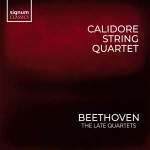|
Back
05/09/2023
“Beethoven: The Late Quartets”
Ludwig van Beethoven: String Quartets n° 12 in E‑Flat major, opus 127, n° 14 in C‑Sharp minor, opus 131, n° 13 in B‑Flat major, opus 130, n° 15 in A minor, opus 132, & n° 16 in F major, opus 135 – Grosse Fuge, opus 133
Calidore Quartet: Jeffrey Myers, Ryan Meehan (violin), Jeremy Berry (viola), Estelle Choi (cello)
Recording: Gore Recital Hall, Roselle Center for the Arts, University of Delaware, Newark, Delaware (February 4, 5, 7, 8, 2021, July 6 – 7, 2021, September 13 – 15, 2021, February 1, 2, 3, 5, 2022) – 203’43
3 CDs Signum Classics SIGCD733 – Booklet in English
   

There comes a time in every string quartet player’s life when they must face The Late Quartets. In a sense, the quartets are a proving ground, a test of technique, synergy, and, let’s face it, endurance. It’s more than a coming of age. It’s a career-making-or-breaking three‑hour journey in which four people bare their souls and unveil the wordless spirit of the universe.
We’re referring, of course, to the last quartets of Ludwig van Beethoven, composed during his final illnesses in 1825 and 1826. Deaf and weakened by liver disease (as we now know from analysis of the composer’s DNA), Beethoven produced these five incomparable works (plus the Grosse Fuge, the original last movement of Quartet n° 13). At the time, audiences found them largely incomprehensible, causing the composer to remark that he was composing not for them, but for future generations.
The Calidore Quartet, formed in Los Angeles in 2010, is one of the latest ensembles to record this epic collection. Since 2021, the ensemble has been on the faculty of the University of Delaware’s School of Music. The name Calidore is taken from their home state, California, and the French word for gold.
I won’t keep you in suspense any longer: this version, while not solid gold, is well worth listening to and adding to one’s collection. The ensemble has that special symmetry which the best musicians achieve when playing repertoire over many years. From the smooth opening of the Quartet n° 12 through the final Quartet n° 16, the Calidore delivers performances of pure beauty and grace, with exceptional sensitivity in two “Adagios” and a “Lento” which may be among the most haunting movements in quartet‑writing history. These quartets flow, rise and crash like waves on a shore, emerging from some place deep within eternity.
One of the first questions posed when faced with a new recording of The Late Quartets is: where to find the Great Fugue? In this recording, it comes just after the fifth movement of Quartet n° 13, as Beethoven originally intended. After the first performance in 1826, the second violinist (and Beethoven confidante) Karl Holz was assigned the unenviable task of persuading the composer to publish the jarring movement as a separate composition. Beethoven agreed, Holz survived, and the Great Fugue became opus 133. In this album, it follows the Cavatina (movement five) and is itself followed, in turn, by the “new” replacement finale. It’s an interesting experiment, but I must confess I prefer to hear this delectably gritty explosion of sound, culminating in a frenzy of joy and ecstasy, all by itself.
Calidore captures the great yearning of the two most sublime quartets: the C‑Sharp minor and the A minor. There may be a touch of conservatism in the playing here, but it issues out of respect rather than excessive caution. Included in the A minor is an elegant reading of the Heiliger Dankgesang, Beethoven’s ethereal hymn of praise during one of his rare respites from suffering.
The album concludes with the Quartet n° 16. “Must it be?” “It must be!”...the strings resound, echoing the words Beethoven scribbled in German on the manuscript. Calidore concludes this cycle with the most spritely and animated of The Late Quartets, beginning and ending with a bright “Allegro”, interjecting a quirky “Vivace”, and weaving in as the third movement another of those divine slow melodies.
Kudos to Jeffrey Myers, violin; Ryan Meehan, violin; Jeremy Berry, viola; and Estelle Choi, cello, for a meaningful interpretation of this summit of the string players’ art.
Linda Holt
|